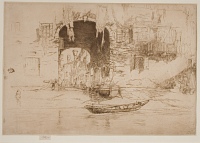San Biagio | ||
| Number: | 237 | |
| Date: | 1880 | |
| Medium: | etching and drypoint | |
| Size: | 212 x 308 mm | |
| Signed: | butterfly at left | |
| Inscribed: | no | |
| Set/Publication: | 'Second Venice Set', 1886 | |
| No. of States: | 17 | |
| Known impressions: | 68 | |
| Catalogues: | K.197; M.194; W.163 | |
| Impressions taken from this plate (68) | ||
TECHNIQUE
While Whistler took San Biagio through many states, the basic composition and his approach to portraying it on the copper plate remained the same. He began the plate in etching, and employed both etching and drypoint for changes as the work progressed. The figures near the right side of the archway remained in flux, as evidenced by additions to and subtractions from the plate, until that area was resolved in the final state.
PRINTING
Over 70 impressions of San Biagio have been located, including four impressions from the cancelled plate. Two impressions of the first state are printed in black ink on buff laid paper; the first is unevenly inked, and definitely a working proof () and the second is more carefully inked, with light tone (). Impressions followed in quick succession: a third state in dark brown ink on ivory laid paper, with a hunting horn watermark (); a fourth in dark brown ink on ivory laid paper (), and a fifth state in black ink on light-weight cream laid paper watermarked 'FELLOWS / 1804' (). Proofs of both sixth and seventh states are on laid paper with a Strasbourg Lily watermark (, ).
This etching obviously needed a long series of alterations through seven states before Whistler was prepared to sell the plate to Messrs Dowdeswell in 1886. Then an impression of an eighth state was printed by Émile Frédéric Salmon (1840-1913), in black ink on pale buff laid paper, possibly an Asian paper (). It was a good clear impression, but a little bare and thin in the shadows of the arch. It had been intended that Salmon should print the set but Whistler was not satisfied and immediately set to work on the plate again.
San Biagio was published by Messrs Dowdeswell and Thibaudeau with the Twenty-six Etchings or the 'Second Venice Set' in 1886. The record of impressions for this edition lists single impressions delivered on 2 April, 22 July, 31 July, 20 August and 15 December 1886; seven on 15 January, seventeen on 8 February and twenty-four on 26 February 1887, a total of 53. 8 This is an unusual pattern, with single impressions printed to make up particular sets, followed by the bulk printing in February 1887.
8: Whistler to W. Dowdeswell, GUW #08717.
The published edition was printed by Whistler in a range of ink colours and a variety of papers. Most were trimmed to the platemark and signed on the tab with Whistler's butterfly and 'imp.' to show that he printed them (or approved them - since he undoubtedly had assistance). Whistler's own impressions of the eighth state are interesting to compare with Salmon's, being, for instance, in brown ink on off-white laid () and cream 'antique' (pre-1800) laid paper () and in black ink on pale buff laid paper (), producing on the whole a warmer colour and atmospheric effect.
Ninth states include impressions in dark brown ink on buff machine-made laid paper () and ivory Asian laid paper (, ). Tenth states are in dark brown ink on fine cream laid paper (), ivory laid () and ivory medium-weight laid paper ().
Several impressions of the later states - from the 11th to 17th - are on an ivory modern machine-made laid paper with a fine canvas-like texture (, , , ). These late impressions were retained by Whistler, who bequeathed them to Rosalind Birnie Philip (1873-1958). In fact a large number - 22 - impressions were still in Whistler's studio at his death and most of these were bequeathed by Rosalind Birnie Philip (1873-1958) to the University of Glasgow. A number were sold or exchanged with other collections, leaving 14 in the Hunterian Art Gallery. They include proofs of various states from the seventh () to the 17th () and interesting examples of different inks, paper, ink tone and wiping.
The largest print-runs occurred in February 1887 and presumably these were all of the final, 17th state. All were printed in brown or dark brown ink, mostly on laid paper in shades from ivory (), cream (), light buff () to tan ().
